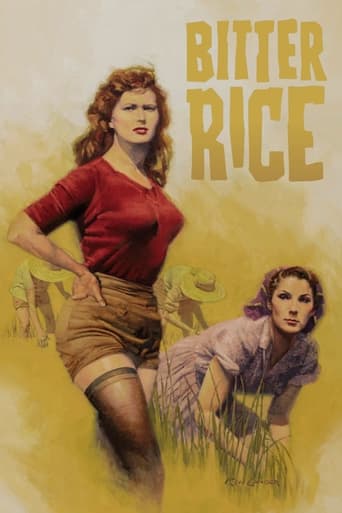Laikals
The greatest movie ever made..!
ReaderKenka
Let's be realistic.
SparkMore
n my opinion it was a great movie with some interesting elements, even though having some plot holes and the ending probably was just too messy and crammed together, but still fun to watch and not your casual movie that is similar to all other ones.
Helloturia
I have absolutely never seen anything like this movie before. You have to see this movie.
JohnHowardReid
Not copyright 1948 by Lux Films. New York opening in a sub-titled version at the World: 18 September 1950. U.S. release through Lux Films (sub-titled version) on 21 September 1950 and through Italian Films Export (dubbed version) in 1952. London opening of the sub- titled version at the Rialto, around March 1950. U.K. release of this version through Gelardi, Rashbrooke. Australian release in an English-dubbed version by RKO Radio Pictures: 7 March 1952. Sydney opening at the Esquire. Running times: 112 minutes (Australia), 103 minutes (London), 107 minutes (New York), 93 minutes (U.S. dubbed version).Original Italian title: RISO AMARO.NOTES: Giuseppe de Santis and Carlo Lizzani were nominated for the 1950 Academy Award for Best Motion Picture Story, losing to "Panic in the Streets."COMMENT: Italian films of the forties and early fifties always pose a bit of an aural dilemma for me. I mean the dubbing. On the whole, I have a preference for the English-dubbed version because in most cases the British or American stars post-sync their own voices, whereas in the Rome version, none of the players — aside from the really big stars like Anna Magnani, Gino Cervi and Amedeo Nazzari — are allowed anywhere near a microphone. It's strange to hear Vittorio Gassman's distinctively throaty voice replaced by a bland radio actor's; and equally disconcerting to find Silvana's peasant girl speaking beautifully cultured high class.Of course, "Bitter Rice" was such a sensational success, it launched not only Mangano, but Gassman and Vallone as well, on to the international scene. Gassman was offered a Hollywood contract and before long was co-starring opposite the likes of Elizabeth Taylor. Mangano continued her career after marrying this film's producer in 1949. Incidentally, "Bitter Rice" was not her first film. She'd previously made L'elisir d'amore for director Mario Costa in 1947. And she was eighteen, not seventeen, when she starred in Riso Amaro.Alas, the film did nothing for the waning career of that ultra- classy siren of "The Blue Dahlia", Doris Dowling. Forced to play second fiddle to Mangano, she's not only dowdily dressed but robbed of her distinctive voice.I thought the attempt to marry documentary neo-realism with a melodramatic plot worked rather well. The realistic backgrounds made the story seem far more credible, whilst at the same time the more sensational aspects of the story lend an added power and poignancy to the plight of the rice workers. The four leading characters are skillfully delineated. The writers give them enough quirks to make their behavior and reactions individualistic without descending into caricature.Director De Santis and photographer Martelli's probing camera explore the teeming settings to the full, assisted by a no-holds- barred budget and an appropriately atmospheric music score.
gavin6942
Francesca and Walter are two-bit criminals in Northern Italy, and, in an effort to avoid the police, Francesca joins a group of women rice workers. She meets the voluptuous peasant rice worker, Silvana, and the soon-to-be-discharged soldier, Marco. Walter follows her to the rice fields, and the four characters become involved in a complex plot involving robbery, love, and murder.In the film, the character Silvana represents enchantment with behavior modeled in American films, such as chewing gum and boogie-woogie dancing. Her downfall shows director Giuseppe De Santis's condemnation of these products of American capitalism. In addition, Silvana was considered by many audiences to be overly-sexualized. This sexualization and the melodramatic presence of death and suicide in the film cause it to diverge from typical Italian neorealism.I do find the symbolism interesting, especially because (as noted) the neorealist films of the era (which have been getting a major re-evaluation as of late) really are pretty straight-forward, very Italian, and often dealing with post-war themes. There is some of that post-war feeling here, but we see less of the "city as a character" and more individuals.On a personal note, I like that this film is an early entry in the DeLaurentiis dynasty. Dino DeLaurentiis produced, and his wife is the star. This is 1949 (just after World War II), and the family is still an important part of Italian and American culture today (2016).
wvisser-leusden
Although its mold of 1949 appears somewhat melodramatic today, the black and white 'Riso Amaro' (= Italian for 'Bitter Rice') surely ranks among the classics in film history.This very Italian product by Guiseppe de Santis shows a pretty ordinary crime story, excellently interwoven with an impressive decor of harsh season labor in the rice-fields of Northern Italy. The thousands of women, up to their ankles in the water, breaking their backs in the burning sun to earn a few bucks, make a truly great setting.'Riso Amaro' has been labeled as 'neo-realism'. Another issue worth mentioning is its female lead Silvana Mangano, ex miss Rome. To the standards of 1949 miss Mangano's performance in this film was shocking. This earned 'Riso Amaro' a lot of publicity, in particular in strongly Roman Catholic Italy.
James Cheney
Riso Amaro is bizarrely and wonderfully paradoxical: a movie that decries and deconstructs Hollywood-style escapism at every turn, and ,yet, is itself as pure an opiate for the masses as is known to Italian cinema.The closest comparison that occurs to me is Sergio Leone's Once Upon a Time in the West. Both fetishize the technical and narrative magic of classic American films, the boundless optimism of the American dream that only soaring crane shots and panoramic vistas filled with casts of thousands (or at least a few dozen) can convey. Both fondly revisit every last genre movie cliche that can be crammed in edgewise. Yet, both are the work of foreigners asserting their alien and alienated status.If your sensibility tends to dialectical Marxism, view Bitter Rice as a fascinating demonstration and critique of lumpen-proletariat "double-consciousness". If you could care less about such things, dig Silvana Mangano and Vittorio Gassman doing a rhumba, or the lovely exploited riceworkers hiking their skirts above their thighs and wading towards a watery catfight with non-union laborers ---or all the other delirious and visionary standout sequences that add up to Gone With the Wind as shot by Sam Fuller. Amazing stuff.In a perfect world, this film would be available in the USA. It isn't at the moment. Slap some subtitles on it somebody, please!

